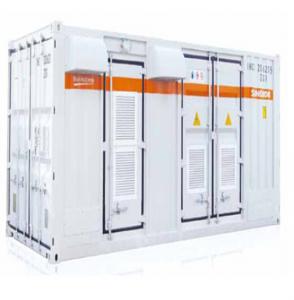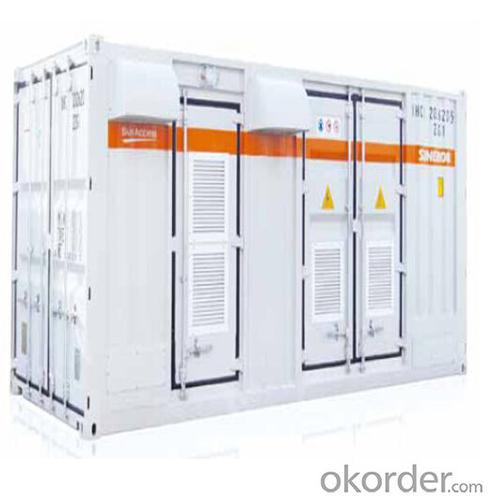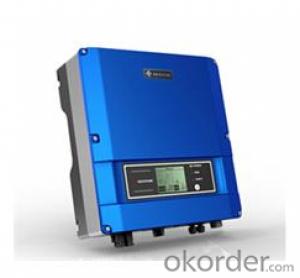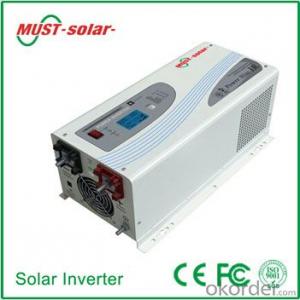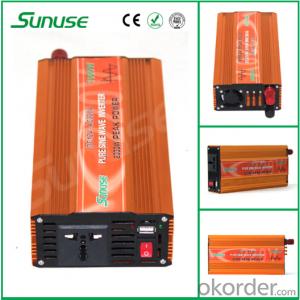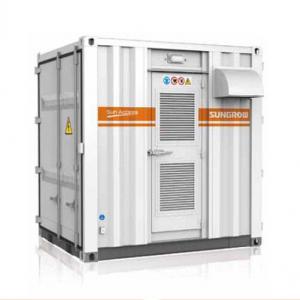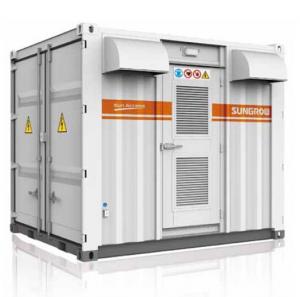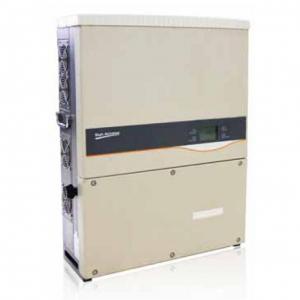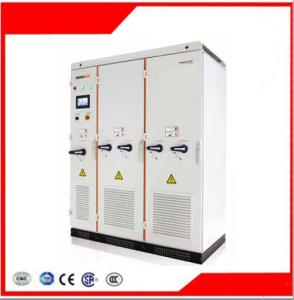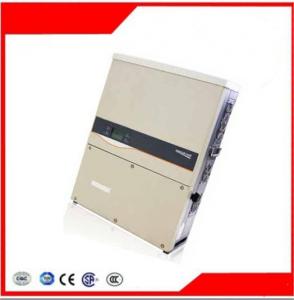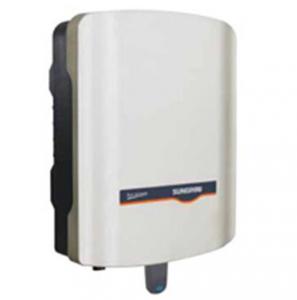Solar Inverter 5000W Photovoltaic Grid-Connected Inverter SG1000TS-MV
- Loading Port:
- China Main Port
- Payment Terms:
- TT or LC
- Min Order Qty:
- 50 unit
- Supply Capability:
- 1000 unit/month
OKorder Service Pledge
OKorder Financial Service
You Might Also Like
1. Structure of Photovoltaic Grid-Connected Inverter SG1000TS-MV Description
A solar inverter, or PV inverter, or Solar converter, converts the variable direct current (DC) output of a photovoltaic (PV) solar panel into
autility frequency alternating current (AC) that can be fed into a commercial electrical grid or used by a local, off-grid electrical network.
It is acritical BOS–component in a photovoltaic system, allowing the use of ordinary AC-powered equipment. Solar inverters have
special functions adapted for use with photovoltaic arrays, including maximum power point tracking and anti-islanding protection.
Suitable for 50Hz/60Hz grid, could be used in Asia, North America and Europe.
2. Main Features of the Photovoltaic Grid-Connected Inverter SG1000TS-MV
• Turn-key solution,high integration
• Integrated PV inverter, DC/AC power distribution, medium-voltage transformer, system monitoring, fire alarm, environment monitoring functional modules and so on
• Save AC cables, lower consumption and promote users’ benefits
• SCADA monitoring system integrated to reduce the costs and ensure the optimal status of the plant
* Easy for Transportation and Handling, Environment Adaptable
• Container design, easy for transportation
• Integral hoisting, easy to install, reduce the installation cost and risks.
• Standard container enclose, integrated design for ventilation, sandproof, anti-corrosion and anti-low-temperature and other application requirements.
* Advanced Technology, Grid-friendly
• Efficiency, energy-saving and reliability as with all Sungrow inverters
• Integrated with standard power dispatch interfaces, convenient and flexible access to power grid;
• LVRT (Zero-voltage Ride-through), Reactive power control with power factor from 0.9 lagging to 0.9 leading, Give reactive power compensation to the grid at night according to directive
3. Photovoltaic Grid-Connected Inverter SG1000TS-MV Images
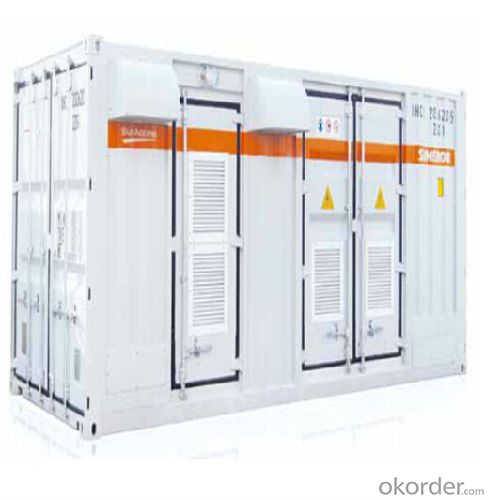

4. Photovoltaic Grid-Connected Inverter SG1000TS-MV Specification
Side Data | |
Max. DC power (@ cos φ =1) | 1120kW |
Max. input voltage | 1000V |
Start voltage | 500V |
Min. working voltage | 460V |
Max. input current | 2440A |
MPPT voltage range | 460~850V |
Number of DC inputs | 16/32 |
Output Side Data | |
Rated power | 1000kW |
Max. output AC power | 1100kVA |
Max. output current | 63.5A |
Max. THD | <3%(at nominal power) |
Rated grid voltage | 10-24kV |
Rated grid frequency | 50Hz / 60Hz |
Grid frequency range | 47~52Hz / 57 ~62Hz |
Power factor at rated power | >0.99 |
DC current injection | <0.5% of rated inverter output current |
Adjustable displacement factor | 0.9 (lagging) ~0.9 (leading) |
Efficiency | |
Max. efficiency | 98.00% |
European efficiency | 97.50% |
Protection | |
DC input side disconnection device | Switch-disconnector with fuses |
AC output side disconnection device | Switch-disconnector with fuses |
DC overvoltage protection | Yes |
AC overvoltage protection on the LV side | Yes |
Grid monitoring | Yes |
Ground fault monitoring | Yes |
Overheat protection | Yes |
Insulation monitoring | Yes |
General Data | |
Dimensions(W×H×D) | 6058x2591x2438mm |
Weight | 12T |
Operating temperature range | -35~50℃ |
External auxiliary supply voltage (Opt.) | 380V |
Cooling concept | Temperature controlled air-cooling |
Degree of protection | IP54 |
Max. permissible value for relative humidity (non-condensing) | 0~95%, non -condensing |
Max. altitude | 6000m (derating > 3000m) |
Communication port/protocols | Standard: RS485/ Modbus, Internet |
Options: CDT, DNP3.0, 101, 103, 104, GPRS/CDMA module | |
5. FAQ of Photovoltaic Grid-Connected Inverter SG1000TS-MV
Q1. What is the difference between inverter and solar inverter?
A1. Inverter only has AC inpput, but solar inverter both connect to AC input and solar panel, it saves more power.
Q2. What is the difference between MPPT&PWM?
A2. MPPT has higher efficiency, it can track the max power point and won't waste energy.
- Q: Can a solar inverter convert DC power to AC power during a power outage?
- No, a solar inverter cannot convert DC power to AC power during a power outage. During a power outage, the solar inverter relies on the grid to function, and without grid power, it cannot convert DC power from the solar panels into usable AC power.
- Q: Can a solar inverter be integrated with smart home systems?
- Yes, a solar inverter can be integrated with smart home systems. Smart home systems allow for the monitoring and control of various devices and appliances in a home, and a solar inverter can be integrated into this system to provide real-time data on solar energy production, as well as the ability to remotely control and optimize the solar power usage in the home.
- Q: How does the weight of a solar inverter affect its installation process?
- The weight of a solar inverter can significantly impact its installation process. Heavier inverters may require additional support structures or mounting equipment to ensure proper installation and stability. They may also require more manpower and specialized equipment during the installation process. Conversely, lighter inverters may be easier to handle and install, potentially reducing installation time and effort. Therefore, the weight of a solar inverter is an important consideration that can influence the overall installation process.
- Q: What are the key features to consider when purchasing a solar inverter?
- When purchasing a solar inverter, some key features to consider include the inverter's power rating, efficiency, type of inverter (string or micro), warranty, monitoring capabilities, and whether it has additional features like grid support or battery compatibility. These features play a vital role in determining the performance, reliability, and compatibility of the inverter with your solar system.
- Q: Can a solar inverter be used in a solar-powered air conditioning system?
- Yes, a solar inverter can be used in a solar-powered air conditioning system. A solar inverter converts the direct current (DC) produced by solar panels into alternating current (AC), which is required to power most appliances including air conditioning units. By using a solar inverter, the solar energy generated by the panels can be efficiently utilized to run the air conditioning system, reducing reliance on the electrical grid and lowering energy costs.
- Q: Can a solar inverter be used in a commercial solar system?
- Yes, a solar inverter can be used in a commercial solar system. A solar inverter is an essential component of a solar system as it converts the direct current (DC) generated by the solar panels into alternating current (AC) that can be used to power commercial buildings and equipment.
- Q: What is the role of a solar inverter in optimizing energy production?
- The role of a solar inverter in optimizing energy production is to convert the direct current (DC) electricity generated by the solar panels into alternating current (AC) electricity that can be used to power homes and businesses. It also helps in managing and controlling the flow of electricity from the solar panels to the grid or batteries, ensuring maximum efficiency and utilization of the generated energy. Additionally, solar inverters monitor the performance of the solar system, providing vital data and feedback to optimize energy production and identify any issues or maintenance requirements.
- Q: Can a solar inverter be used in remote locations?
- Yes, solar inverters can be used in remote locations. They are designed to convert the direct current (DC) generated by solar panels into alternating current (AC) that can be used to power electrical devices. Solar inverters are versatile and can be installed and operated in various settings, including remote locations where grid electricity is not available. These inverters allow for the utilization of solar energy in off-grid areas, making them an ideal choice for powering remote homes, cabins, or other facilities.
- Q: How does a solar inverter affect the overall system efficiency at different temperatures?
- A solar inverter can affect the overall system efficiency at different temperatures by adjusting its power conversion efficiency based on the temperature conditions. In hot temperatures, solar inverters can experience lower conversion efficiencies, resulting in decreased overall system efficiency. This is due to increased internal resistance and heat losses in the inverter components. On the other hand, in colder temperatures, the inverter can operate more efficiently, as lower temperatures generally lead to reduced internal losses and improved performance. Therefore, the temperature conditions can have an impact on the efficiency of a solar inverter and subsequently affect the overall system efficiency.
- Q: What is the role of ground fault protection in a solar inverter?
- The role of ground fault protection in a solar inverter is to detect and respond to any faults or abnormalities in the electrical system, specifically related to the grounding of the system. It ensures the safety of the inverter, the solar panels, and the overall electrical system by interrupting the flow of current in the event of a ground fault, preventing potential electric shock hazards and damage to the equipment.
Send your message to us
Solar Inverter 5000W Photovoltaic Grid-Connected Inverter SG1000TS-MV
- Loading Port:
- China Main Port
- Payment Terms:
- TT or LC
- Min Order Qty:
- 50 unit
- Supply Capability:
- 1000 unit/month
OKorder Service Pledge
OKorder Financial Service
Similar products
Hot products
Hot Searches
Related keywords
